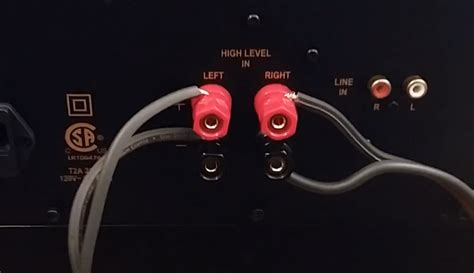Hear the Difference: Connecting a Subwoofer to Your Stereo Amp
Adding a subwoofer to your stereo system can dramatically enhance your listening experience, injecting powerful low-end frequencies that breathe life into your music and movies. However, connecting it correctly is crucial to achieving optimal sound. This guide will walk you through the process, clarifying common questions and ensuring you get the most from your subwoofer.
What are the different types of subwoofer connections?
Subwoofers typically connect to stereo amplifiers via two primary methods: line-level inputs and speaker-level inputs. Understanding the difference is essential for choosing the right connection method for your system.
-
Line-Level Inputs (RCA): These are the most common type of connection, utilizing RCA jacks (those red and white plugs). Line-level signals are relatively low in voltage and are ideal for avoiding signal degradation. Many modern amplifiers and subwoofers use this method.
-
Speaker-Level Inputs (Binding Posts): This method involves connecting the subwoofer directly to the speaker outputs of your amplifier. This bypasses the preamplifier stage, often resulting in a slightly higher signal level but can also introduce noise if not properly implemented. High-end subwoofers might include this type of connection, especially for those who prefer to preserve the amplifier's built-in crossover.
How do I connect a subwoofer with line-level inputs?
Connecting via line-level inputs is usually straightforward. Here's a step-by-step guide:
-
Identify the RCA outputs on your amplifier. These are usually labeled as "Subwoofer Out," "Pre-Out," or something similar.
-
Locate the RCA inputs on your subwoofer. These will also be clearly marked.
-
Use RCA cables to connect the amplifier's outputs to the subwoofer's inputs. Ensure you match the colors (red to red, white to white). Poor quality cables can affect sound quality, so invest in a decent pair if possible.
-
Power on both your amplifier and subwoofer. You should now be able to hear the bass frequencies being reproduced by the subwoofer.
-
Adjust the subwoofer's volume and crossover frequency. Experiment with these settings to find the optimal balance between bass and overall system clarity.
How do I connect a subwoofer with speaker-level inputs?
Connecting via speaker-level inputs is slightly more involved and generally requires a specialized cable.
-
Disconnect your main speakers from your amplifier.
-
Use a speaker-level to line-level converter (if needed). Some subwoofers have built-in converters; others require a separate unit. This is necessary because the subwoofer's amplifier needs a line-level signal, not a high-powered speaker-level signal.
-
Connect the speaker-level inputs of the converter (or subwoofer) to the speaker outputs of the amplifier.
-
Connect the line-level outputs of the converter (or subwoofer) to your subwoofer's line-level inputs (if applicable). If your subwoofer has direct speaker-level inputs, you'll connect the speaker cable directly.
-
Reconnecting your main speakers: After connecting the subwoofer, reconnect your main speakers.
-
Power on both your amplifier and subwoofer.
What is a subwoofer crossover and how does it work?
The crossover is a crucial setting that determines the frequency range handled by your subwoofer versus your main speakers. It prevents your main speakers from attempting to reproduce frequencies they're not designed for (and potentially causing damage), and ensures a seamless blend between the subwoofer and the main speakers. It's usually adjustable, allowing you to fine-tune the bass response to your preference. Experimenting with the crossover frequency is key to achieving optimal sound.
Why is my subwoofer not working?
Troubleshooting a non-functional subwoofer can be simple or complex. Here are some common causes:
-
Incorrect wiring: Double-check all connections to ensure proper polarity (red to red, white to white) and secure connections.
-
Power issues: Make sure the subwoofer is plugged in and receiving power. Check the circuit breaker or fuse.
-
Phase issues: Incorrect phase settings can result in a weak or cancelled bass response. Experiment with changing the phase setting (usually 0 or 180 degrees) on the subwoofer.
-
Low-level signal issues: If using a line-level connection, check the level of the subwoofer output on your amplifier.
How do I choose the right subwoofer for my system?
Selecting the right subwoofer depends on your room size, listening preferences, and amplifier capabilities. Research different models, read reviews, and consider factors like power handling, frequency response, and size. A larger room usually requires a more powerful subwoofer. Consult professional audio retailers if needed.
By following these steps and understanding the principles behind subwoofer integration, you can significantly enhance your audio system's performance and enjoy a richer, more immersive listening experience. Remember to always refer to your amplifier and subwoofer manuals for specific instructions.

